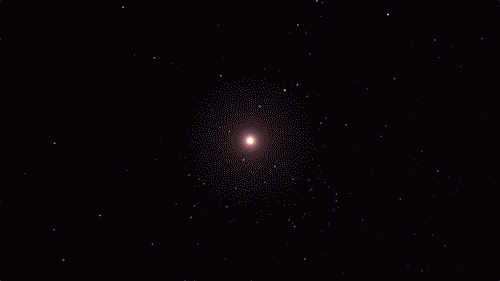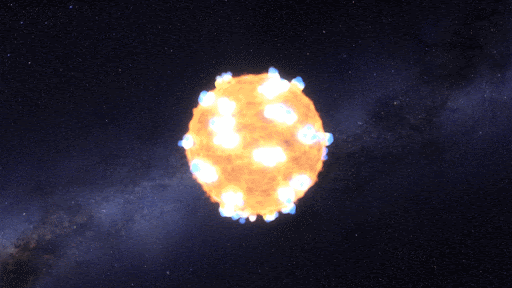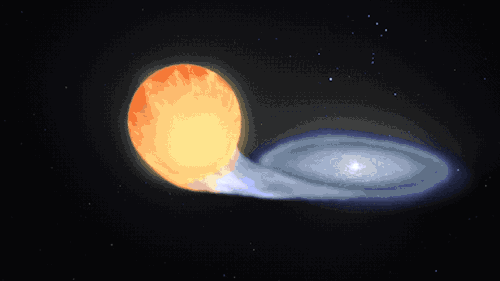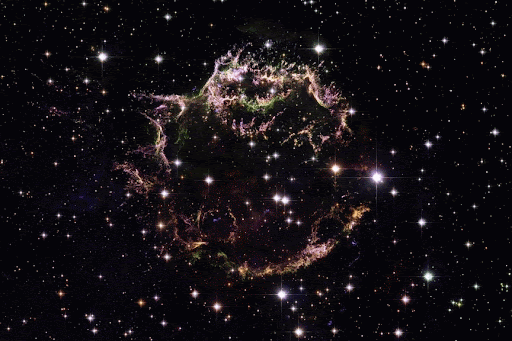Space Welder - B S










Space welder - B S
More Posts from Epic-flight and Others

A crater on Mars, observed by the Mars Reconnaissance Orbiter: “This impact crater appears relatively recent as it has a sharp rim and well-preserved ejecta, the material thrown out of the crater when a meteorite hit Mars. The steep inner slopes are carved by gullies and include possible recurring slope lineae (known as RSL) on the equator-facing slopes. RSL could be a sign that water, its freezing point lowered by a high concentration of salt, could be seeping down these steep slopes. MRO has seen RSL appear in warmer seasons and disappear in cooler seasons in a few locations on Mars, indicating a planet with plenty of active processes.” (NASA)

Mountain Lake - 210408

You Are Made of Stardust
Though the billions of people on Earth may come from different areas, we share a common heritage: we are all made of stardust! From the carbon in our DNA to the calcium in our bones, nearly all of the elements in our bodies were forged in the fiery hearts and death throes of stars.

The building blocks for humans, and even our planet, wouldn’t exist if it weren’t for stars. If we could rewind the universe back almost to the very beginning, we would just see a sea of hydrogen, helium, and a tiny bit of lithium.
The first generation of stars formed from this material. There’s so much heat and pressure in a star’s core that they can fuse atoms together, forming new elements. Our DNA is made up of carbon, hydrogen, oxygen, nitrogen, and phosphorus. All those elements (except hydrogen, which has existed since shortly after the big bang) are made by stars and released into the cosmos when the stars die.

Each star comes with a limited fuel supply. When a medium-mass star runs out of fuel, it will swell up and shrug off its outer layers. Only a small, hot core called a white dwarf is left behind. The star’s cast-off debris includes elements like carbon and nitrogen. It expands out into the cosmos, possibly destined to be recycled into later generations of stars and planets. New life may be born from the ashes of stars.

Massive stars are doomed to a more violent fate. For most of their lives, stars are balanced between the outward pressure created by nuclear fusion and the inward pull of gravity. When a massive star runs out of fuel and its nuclear processes die down, it completely throws the star out of balance. The result? An explosion!
Supernova explosions create such intense conditions that even more elements can form. The oxygen we breathe and essential minerals like magnesium and potassium are flung into space by these supernovas.

Supernovas can also occur another way in binary, or double-star, systems. When a white dwarf steals material from its companion, it can throw everything off balance too and lead to another kind of cataclysmic supernova. Our Nancy Grace Roman Space Telescope will study these stellar explosions to figure out what’s speeding up the universe’s expansion.
This kind of explosion creates calcium – the mineral we need most in our bodies – and trace minerals that we only need a little of, like zinc and manganese. It also produces iron, which is found in our blood and also makes up the bulk of our planet’s mass!

A supernova will either leave behind a black hole or a neutron star – the superdense core of an exploded star. When two neutron stars collide, it showers the cosmos in elements like silver, gold, iodine, uranium, and plutonium.

Some elements only come from stars indirectly. Cosmic rays are nuclei (the central parts of atoms) that have been boosted to high speed by the most energetic events in the universe. When they collide with atoms, the impact can break them apart, forming simpler elements. That’s how we get boron and beryllium – from breaking star-made atoms into smaller ones.
Half a dozen other elements are created by radioactive decay. Some elements are radioactive, which means their nuclei are unstable. They naturally break down to form simpler elements by emitting radiation and particles. That’s how we get elements like radium. The rest are made by humans in labs by slamming atoms of lighter elements together at super high speeds to form heavier ones. We can fuse together elements made by stars to create exotic, short-lived elements like seaborgium and einsteinium.

From some of the most cataclysmic events in the cosmos comes all of the beauty we see here on Earth. Life, and even our planet, wouldn’t have formed without them! But we still have lots of questions about these stellar factories.
In 2006, our Stardust spacecraft returned to Earth containing tiny particles of interstellar dust that originated in distant stars, light-years away – the first star dust to ever be collected from space and returned for study. You can help us identify and study the composition of these tiny, elusive particles through our Stardust@Home Citizen Science project.
Our upcoming Roman Space Telescope will help us learn more about how elements were created and distributed throughout galaxies, all while exploring many other cosmic questions. Learn more about the exciting science this mission will investigate on Twitter and Facebook.
Make sure to follow us on Tumblr for your regular dose of space!

Traverse - 211226
Nuclear Winter and the End of the Arms Race: Carl Sagan Interview (1991)
A powerful and prophetic interview, as always, with Professor Sagan. Contrary to the video’s title, topics discussed range from science education, nuclear disarmament, economics, and critique of America. Sagan responds to queries from callers.


Lynds Dark Nebula 1251 : Stars are forming in Lynds Dark Nebula (LDN) 1251. About 1,000 light-years away and drifting above the plane of our Milky Way galaxy, the dusty molecular cloud is part of a complex of dark nebulae mapped toward the Cepheus flare region. Across the spectrum, astronomical explorations of the obscuring interstellar clouds reveal energetic shocks and outflows associated with newborn stars, including the telltale reddish glow from scattered Herbig-Haro objects seen in this sharp image. Distant background galaxies also lurk on the scene, buried behind the dusty expanse. This alluring view imaged with a backyard telescope and broadband filters spans about two full moons on the sky, or 17 light-years at the estimated distance of LDN 1251. via NASA
The amazing final seconds of yesterday’s Starship landing. @spacex https://www.instagram.com/p/CInrXfSniww/?igshid=1b5o8ndalzcq9
-
 mazzumblr reblogged this · 1 month ago
mazzumblr reblogged this · 1 month ago -
 encrpted liked this · 7 months ago
encrpted liked this · 7 months ago -
 dbretz76db liked this · 11 months ago
dbretz76db liked this · 11 months ago -
 take-ivy liked this · 1 year ago
take-ivy liked this · 1 year ago -
 0815-4711-02 liked this · 2 years ago
0815-4711-02 liked this · 2 years ago -
 kitezh-studios reblogged this · 3 years ago
kitezh-studios reblogged this · 3 years ago -
 johnnyshigepp liked this · 3 years ago
johnnyshigepp liked this · 3 years ago -
 foxxyfox2 liked this · 3 years ago
foxxyfox2 liked this · 3 years ago -
 aviationgeek71 liked this · 3 years ago
aviationgeek71 liked this · 3 years ago -
 5050gregbrown liked this · 3 years ago
5050gregbrown liked this · 3 years ago -
 ffloydy liked this · 3 years ago
ffloydy liked this · 3 years ago -
 meisterarch reblogged this · 3 years ago
meisterarch reblogged this · 3 years ago -
 meisterarch liked this · 3 years ago
meisterarch liked this · 3 years ago -
 griffinharper liked this · 3 years ago
griffinharper liked this · 3 years ago -
 kedongma liked this · 3 years ago
kedongma liked this · 3 years ago -
 grayrea liked this · 3 years ago
grayrea liked this · 3 years ago -
 5150juanfer reblogged this · 3 years ago
5150juanfer reblogged this · 3 years ago -
 strstruckcomiccsanimeoperator liked this · 3 years ago
strstruckcomiccsanimeoperator liked this · 3 years ago -
 copperwaverider liked this · 3 years ago
copperwaverider liked this · 3 years ago -
 thedeadareallliving liked this · 3 years ago
thedeadareallliving liked this · 3 years ago -
 capnash reblogged this · 3 years ago
capnash reblogged this · 3 years ago -
 blackyjunkgallery liked this · 3 years ago
blackyjunkgallery liked this · 3 years ago -
 csapeti liked this · 3 years ago
csapeti liked this · 3 years ago -
 worldsofworlds reblogged this · 3 years ago
worldsofworlds reblogged this · 3 years ago -
 proximio-5 liked this · 3 years ago
proximio-5 liked this · 3 years ago -
 fobos001 liked this · 3 years ago
fobos001 liked this · 3 years ago -
 drkcastr420 reblogged this · 3 years ago
drkcastr420 reblogged this · 3 years ago -
 punchlineloser reblogged this · 3 years ago
punchlineloser reblogged this · 3 years ago -
 punchlineloser liked this · 3 years ago
punchlineloser liked this · 3 years ago -
 outpostzero reblogged this · 3 years ago
outpostzero reblogged this · 3 years ago -
 outpostzero liked this · 3 years ago
outpostzero liked this · 3 years ago -
 der-architekt reblogged this · 3 years ago
der-architekt reblogged this · 3 years ago

